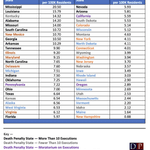
A DPIC analysis of 2020 U.S. homicide data has found that murder rates during the pandemic were highest in states with the death penalty and lowest in long-time abolitionist states.
DPIC reviewed the 2020 murder data compiled by the center-left think tank The Third Way for its March 2022 report, The Red State Murder Problem. Then, taking the analysis out of the realm of politics and into the context of public policy, DPIC compared the data to states’ death-penalty status and historic usage of the death penalty. That analysis found that pandemic murder rates generally correlated not just with the presence or absence of the death penalty in a state but with the state’s general level of death-penalty usage.
The data show that nine of the ten states with the highest pandemic murder rates1 — ranging from 9.9 to 20.5 murders per 10,000 residents — are death penalty states. On the other hand, eight of the eleven states with the lowest pandemic murder rates — ranging from 0.88 to 3.49 murders per 10,000 residents — had abolished the death penalty.2 DPIC found that the three death penalty states with the lowest pandemic murder rates3 — all 2.89 murders per 10,000 residents — have not carried out an execution in more than a decade,4 and one had a gubernatorial moratorium on executions.5
Murder rates in the mostly high death-penalty usage, high pandemic-murder-rate states ranged from roughly triple to 23 times higher than in the mostly no death penalty, low pandemic-murder-rate states.
More than half of all death penalty states (14 of 27) had pandemic murder rates of at least 7.00 per 100,000 residents, and 30 percent (8 states) had pandemic murder rates of 10.29 per 100,000 residents or higher. By contrast, nearly two-thirds of the states that had abolished the death penalty (15 of 23) had pandemic murder rates of 5.14 or less per 100,000 residents, more than a third (8 states) had pandemic murder rates below 3.5 murders per 100,000 residents.

An October 31, 2022 Pew Research Poll noted a disconnect between crime data and the American’s perception of crime after being exposed to a tsunami of partisan midterm election advertising that falsely blamed Democrats and reform prosecutors for a rise in violent crime during the COVID pandemic. Pew noted that, in fact, “[a]nnual government surveys from the Bureau of Justice Statistics show no recent increase in the U.S. violent crime rate.” Although murder rates have “risen significantly during the pandemic” and the “roughly 30% increase in the U.S. murder rate between 2019 and 2020 [was] one of the largest year-over-year increases ever recorded,” Pew reported that “the rate remained well below past highs, and murder remains the least common type of violent crime overall.”
Contrary to the claims in the political attack ads, research by the center-left think tank The Third Way found what it called a “red state murder problem.” The increase in murders, The Third Way reported in March 2022, “is a problem that afflicts Republican-run cities and states as much or more than the Democratic bastions,” with per capital murder rates in 2020 “40% higher in states won by Donald Trump than those won by Joe Biden.”
Fact checking the attacks on progressive prosecutors, a multi-university collaborative of researchers found “no evidence to support the claim that progressive prosecutors were responsible for the increase in homicide during the pandemic or before it.” In a report released by the University of Toronto’s Munk School of Global Affairs and Public Policy on October 20, 2022, researchers from the University of Toronto, University of Missouri, St. Louis, Boston University, Temple University, Loyola University of Chicago, and Rutgers University revealed that fewer cities served by “progressive” prosecutors recorded an increase in homicide (56%) compared to cities served by “middle” prosecutors (62%), and those served by “traditional” prosecutors (68%).
The researchers “also found that the proportional increase in homicide was lower in cities served by prosecutors deemed ‘progressive’ (43 percent) than those considered ‘middle’ (53 percent) or ‘traditional’ (55 percent). Finally, the increase in homicide was more extreme in cities with traditional prosecutors: homicides more than doubled in 4 of the cities served by traditional prosecutors, compared to just 1 of the cities whose prosecutors were deemed progressive.”
DPIC’s Analysis of the 2020 Pandemic Murder Data
DPIC’s review of The Third Way pandemic murder data found that 15 of the 20 states with the highest pandemic murder rates are death penalty states,6 of which 12 have carried out 20 or more executions each in the past half century.7 Collectively, these 12 states have accounted for more than three quarters of all executions in the U.S. since the 1970s.8
At the other end of the spectrum, none of the 23 states with the lowest pandemic murder rates are historically heavy users of capital punishment. Fifteen had abolished the death penalty,9 including nine who had not had the death penalty at any time during the 21st century.10 The eight death penalty states with the lowest pandemic murder rates include two with moratoria on executions,11 six who have executed five or fewer people in the past half century,12 one that has carried out seven executions,13 and six who have not executed anyone in more than a decade.14
Twenty U.S. states have carried out ten or more executions in the past half-century. All of them, including three who have since abolished the death penalty, are among the 28 states with the highest pandemic murder rates.
Endnotes
1. In order of highest per capita murder rates, they are: Mississippi, Louisiana, Kentucky, Alabama, Missouri, South Carolina, Georgia, Arkansas, and Tennessee.
2. In order of lowest per capital murder rates, they are: New Hampshire, Maine, Vermont, Massachusetts, Minnesota, Hawaii, Rhode Island, and Iowa.
3. In order of lowest per capital murder rates, they are: Idaho, Utah, and Oregon.
4. See Death Penalty Information Center, States With No Recent Executions.
5. Oregon.
6. They include the states in endnote 1, plus North Carolina, Indiana, Oklahoma, Pennsylvania, Ohio, and Texas.
7. See Death Penalty Information Center, Executions by State and Region Since 1976.
8. Id. Collectively, they have accounted for 1,188 of the 1,552 executions in the United States in the modern era (76.5%).
9. They include the states in endnote 2, plus New Jersey, Washington, Connecticut, North Dakota, New York, Wisconsin, and Colorado.
10. In order of lowest per capital murder rates, they are: New Hampshire, Maine, Vermont, Massachusetts, Minnesota, Hawaii, Rhode Island, Iowa, North Dakota, and Wisconsin.
11. Oregon and California.
12. Wyoming (1), Oregon (2), Idaho (3), Montana (3), Nebraska (4), and South Dakota (5).
13. Utah.
14. California, Idaho, Montana, Oregon, Utah, and Wyoming.
John Gramlich, Violent crime is a key midterm voting issue, but what does the data say?, Pew Research Center, October 31, 2022; Rachel Eisenberg and Allie Preston, Progressive Prosecutors Are Not Tied to the Rise in Violent Crime, Center for American Progress, October 26, 2022 Homicide Rise Slower In Places With Progressive Prosecutors, Study Says, National Criminal Justice Association, October 20, 2022; Todd Foglesong, Ron Levi et al, Violent crime and public prosecution: A review of recent data on homicide, robbery, and progressive prosecution in the United States, University of Toronto, Munk School of Global Affairs and Public Policy, October 20, 2022; Kylie Murdock and Jim Kessler, The Red State Murder Problem, March 15, 2022.
DPIC analysis by Robert Dunham, 11/8/22.


